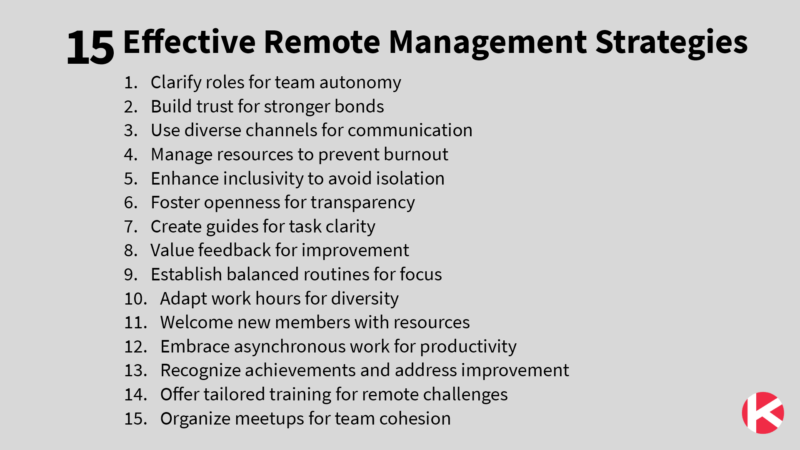
Remote and hybrid work are now the new normal. As companies embrace this work, managers may struggle to manage a remote team effectively. To help you adjust to remote work arrangements, we delve deeply into remote team management practices to share with you the best ones in this article. Overcome your key challenges and thrive as the best remote team in your industry.
Key Takeaways
- While remote and hybrid work is growing in popularity in companies around the world, there are many challenges in managing remote teams.
- Remote teams are more than WFH teams. Managers have access to a broader talent pool, with workers choosing their offices around the world.
- One of the best ways to manage a remote team from the start is by embracing asynchronous work, providing constructive feedback, managing resource allocation, and more.
With Kanban Zone, managing remote teams won’t feel like a chore or punishment. Try using our portfolio Kanban for free and embrace Agile for remote teams first-hand or continue reading this article to learn more about these strategies.
Understanding Remote Teams
Remote teams have been a thing for a while. However, the term was more synonymous with work-from-home work arrangement, than work-from-anywhere style. With the challenges the global pandemic brought, companies had to adapt to remote work and adopt new practices in work management.
Now that companies are going back to how they were before, working remotely is facing a new set of challenges. There are many new technologies and tools that can help the remote workstyle thrive, but changing work dynamics are leaving managers with a new set of challenges that they struggle to address.
What Defines a Remote Team?
Remote teams work beyond the traditional office setup. The employees in remote teams work from home or other locations around the world, embracing flexibility and tech that make that workstyle possible.
Working remotely is more than just working from home. It’s an inclusive work-from-anywhere model, which presents new opportunities and hurdles for team leaders.
Challenges of Managing Remote Teams
Managers face different challenges in managing remote teams. Here are the most common ones.
- Lack of face-to-face communication leads to communication barriers and lack of trust and transparency among team members who are not geographically co-located.
- Different time zones that team members work in cause difficulties in managing real-time collaboration, which additionally challenges communication among the team members.
- Lack of good-quality hardware and equipment that could ensure seamless collaboration.
- Managers are not equipped with the right tools to work with their peers, causing micromanagement problems and constantly ringing up the employees.
- If management isn’t experienced with remote work, they may struggle to adapt leadership styles for virtual environments.
- Online work poses risks when it comes to protecting sensitive information and ensuring all workers use end-to-end encryption.
- Feelings of isolation among team members often come as a challenge in working remotely.
15 Effective Remote Management Strategies

1. Establish your Responsibilities
As a remote team manager, you need to establish your responsibilities and not constantly micromanage your team. Your responsibility is not to look for mistakes your peers make, but also encourage them, motivate them, and become their supporters.
Oftentimes in a remote team, it’s hard to define the responsibilities for the entire team, which is why managers who can’t see or work with their employees in person begin to micromanage them and constantly check on them, which makes employees feel like they are constantly under surveillance, even though they did nothing wrong.
Make sure that your entire team knows what their responsibilities are. If they don’t, you should create an environment where they won’t be scared to ask for guidance. Additionally, by using collaboration tools for remote workers, each team member can know what they should work on.
2. Develop a Work Culture with Trust as Its Foundation
If you’re going to manage a remote team, you need to make sure your team members trust you and can rely on you.
Building and maintaining trust is one of the greatest challenges to overcome in a remote team. Your job as a manager won’t be easy, so make sure to get to know your team members, find common interests, and build relationships based on trust.
3. Clear and Straightforward Communication
Remote leadership means thinking outside the box when it comes to communication with your team members.
They are dispersed across the country, and maybe even around the globe, which is why it’s important to utilize multiple communication channels and communicate in times that are most appropriate to different time zones.
Still, don’t scatter the communication too much. Keep the most important information in your ticketing or collaboration tools and keep certain parts of communication like meetings only on Zoom.
Lastly, utilizing a conversation tool for clearing confusion, or clarification like Slack and Microsoft Teams is the best way to ask any questions or provide additional details regarding some part of the project.
4. Introduce a Proper Resource Management System
One thing distributed teams struggle the most with is a proper resource allocation system. In that struggle, setting the boundaries can be even more daunting.
While it’s still possible to manage resource allocation and work items, oftentimes it’s not efficient enough. Always be careful not to overburden your team members with too many tasks and resources. When you see that they’re performing well, reward them – but not with more work.
5. Team Engagement to Overcome Isolation and Feeling of Not Belonging
When you have a team that operates from different locations around the world, you’re immersed in multiple cultures and lifestyles, and we can guarantee you – they’re all different and unique in their own way.
Some team members may feel overwhelmed by such a huge cultural difference and may find themselves feeling isolated, which can lead to negative emotions that need to be processed.
As a manager, you should ensure to embrace the team members who feel left out and help them get that sense of belonging back, either through more engaging team meetings, team-building activities and other actions.

6. Encouraging a Culture of Trust and Transparency
You won’t achieve great results as a team if you don’t trust one another. Trust is built on small things like proactive communication in meetings, using microphones and cameras, maintained on large projects, being open to feedback, and more.
The first person you should start with is you. Once your team sees you’re transparent and reliable, they’ll also begin opening up and being honest with you.
7. Develop Well-Documented Procedures
Your team should know what to do in certain situations, especially if you work in a team with multiple time zones and you won’t always be online to help them out.
At Kanban Zone, we have a special board with documentation and instructions on how we handle different tasks and which additional tools we may utilize. It’s a great way to simplify difficult tasks so your team can conduct the work without waiting for you or a person assigned for problem-solving to go online.
8. Be Open to Feedback
You can’t always be right. It’s okay to admit to your mistakes and seek to do better in the future. Provide feedback, but also listen to it and be open to changes. Moving forward is not always about leaving your comfort zone, but creating one that moves forward with you.
9. Develop Structures
We mentioned earlier that you need to know how to set responsibilities for your team. However, you also need to ensure that the meetings and other internal responsibilities won’t take too much time.
You can establish structures in work that will block only a certain amount of time dedicated to meetings, deep work, and edits. That way, no one will feel overwhelmed or burnt out and the right priorities will be established.
10. Be Flexible Around Working Hours
Understand the diversity of your remote team. They may look from different locations and with different time zones. Building a remote team with a large time zone difference is a bold move but can also be daunting.
Managing a remote team with diverse time zones requires flexibility and understanding. It’s crucial to establish clear communication channels and schedules that accommodate everyone’s availability. A useful time clock app can assist in tracking work hours across different time zones, ensuring accurate attendance records and streamlined collaboration.
That’s why you can establish a work hours window during which your team members can work. For example, your work hours window can be from 9:00 AM until 7:00 PM EST, your team members can choose when they’ll work within that window.
11. Optimize Onboarding
Onboarding your employees in person is one thing, introducing them to your remote environment is a completely different thing.
One of the best practices for managing remote teams is to be there for them from the start. When a new remote team member joins the team, provide them with a comprehensive digital welcome packet.
Additionally, you need to ensure they have access to the necessary tools and information upfront. Moreover, introducing a mentorship system where new hires are paired with experienced team members for guidance has shown to be very effective for employee onboarding.
Aside from mentorship, make them feel welcome by utilizing interactive and engaging online training modules. This will help enhance learning and integration into the team culture.
12. Support Asynchronous Work when Possible
As you manage a remote team, you’ll come to understand that synchronous work won’t always be possible.
Optimizing your organizational culture means you’ll need to engage in supporting asynchronous work, which requires clear communication channels on apps like Slack or Zoom and robust project tools to keep track of progress and deadlines.
This will allow team members to contribute to their own schedules. Encourage your team to use recorded video updates and shared documents to maintain transparency and continuity.
13. Provide Continuous Feedback
Feedback shouldn’t only be negative. You can also provide feedback while recognizing your team member’s strengths and excellence.
Due to a lack of in-person communication, your team members may feel isolated and misunderstood, which can lead to conflicts when reviewing someone’s work performance. If you manage a remote team, you need to recognize these instances and address them so they won’t create gaps in communication and collaboration.
That’s why while providing feedback, you should also give props to work well done and use that to provide the feedback. Being transparent, but also comforting while providing feedback, will help remote employees to get more productive without making them feel invalidated.
14. Provide Training and Education That Focus on Remote Working
Building a remote team can be hard to manage at first. However, with proper training, any remote worker can optimize your company’s ecosystem.
As you’re transitioning to a fully remote company, training tailored for a remote environment becomes especially important, because your employees will develop new skills and expertise that revolve around remote work.
15. Include Physical Meetings if Possible
Although it’s easier to organize a meetup when working with hybrid teams, it’s still possible to have your entire team meet up at least once a year.
Many companies have a practice to book a team building trip in a popular touristic location where the entire team can get to know each other and connect. If possible, you can even do it more than once a year and celebrate small victories and milestones, while growing internal connections within your team which is not possible while video conferencing.
How Great Remote Managers Develop a Strong Remote Team Culture
Great remote managers know the importance of building and maintaining a remote culture. They focus on the development of cohesive practices while integrating effective team-building activities.
With proper management, organizations can overcome the challenges caused by distance, varying time zones, and lack of in-person collaboration.
Here’s an overview of how remote managers build remote team culture and manage a remote team inside of it.
Developing a Strong Remote Team Culture
Great managers know the importance of complete alignment in the team, whether it’s on-site, in a hybrid, or remote work setting. They utilize various communication tools and know how much is too much.
That helps them ensure that information flows freely and transparently among team members. Remote management is much like in-person management, with extra steps that ensure transparency and respect in the team circle.
Regular video calls, chat groups, and virtual meetings can mimic the immediacy of in-office communication. Don’t forget the importance of sharing core values and encouraging your team members to embody these principles in daily work and interactions.
To manage a remote team that thrives, you must embrace inclusivity. That comes from creating an environment where everyone can express themselves and feel valued and safe, regardless of their location.
Adapting HR Practices for Remote Work Environments
Adapt HR policies for remote work, including flexible hours and mental health days. Offer support for home office setups. Develop clear metrics and KPIs for remote realities. Focus performance reviews on output, not hours.
Create an onboarding process with virtual introductions and training. Include mentorship programs for team integration. As your team grows and becomes more successful, they’ll appreciate the onboarding that helped them increase process efficiency.
Cultivating a Sense of Community within a Remote Team
Keep your employees in the loop with all events that happen in the organization. Managers need to organize regular virtual coffee breaks or happy hours for socializing.
Use platforms like Slack for interest-based channels, to connect over common interests and allow your team to get to know each other.
Implementing Team Building Activities for Remote Employees
Encourage team members to lead virtual workshops in their areas of expertise or hobbies.
This not only helps in skill development but also allows team members to get to know each other on a personal level. Also, invest in different team-building activities that can help your team be much more effective even when facing typical challenges in the remote team setting.
- Virtual Escape Rooms. Teams work together to solve puzzles and escape virtual rooms, fostering problem-solving and teamwork.
- Online Trivia Quizzes. Host themed trivia sessions where teams compete on various topics, enhancing camaraderie.
- Gaming Sessions. Organize multiplayer gaming events with team-based games, promoting strategic collaboration.
- Virtual Workshops. Team members share knowledge or hobbies through online presentations, boosting personal connections.
- Cook-Along Sessions. Everyone follows a recipe together online, sharing their results and experiences, promoting a fun, shared activity.
- Book Clubs. Monthly discussions on selected books can spark insightful conversations and deeper understanding among team members.
- Virtual Fitness Challenges. Encourage healthy competition with fitness goals and challenges, supporting team members’ well-being.
- Photo Sharing Contests. Team members share photos based on themes (e.g., pets, workspaces), fostering a sense of community.
- Remote Retreats. Plan in-person meetups for team bonding and strategic planning, deepening interpersonal relationships.
- Peer Mentoring Programs. Pair team members for mutual skill exchange and mentorship, enhancing personal growth and team unity.
Manage a Remote Team with Portfolio Kanban
We discussed practices and strategies for managing a remote team, but that’s not enough to be a successful leader.
Collaboration is the key in every team including remote and hybrid teams. With a portfolio Kanban, you can track your team’s performance much smoother, optimize workflow, and generate insights through direct reports.
As a remote-first team, Kanban Zone recognizes the struggles managers face in leading remote and hybrid teams and delivers a solution that will not only address those challenges but open more space for growth and better productivity.
If you want to manage a remote team, try Kanban Zone free or schedule a free consultation with our Agile experts and collaborate with your teams to achieve greatness!
Learn to Work Smarter, Not Harder!
Get our top articles weekly.
Table Of Contents
Discover many more posts…








